Corn earworm (=bollworm) moth captures have started to climb in local black light traps. Sara Rutherford (Greensville ANR Agent) reported a nightly average of 17.7 moths; Scott Reiter (Prince George ANR Agent) had 6.5 per night at Templeton and 10.3 at Disputanta; and we averaged 17.9 in Suffolk. Here is the Table. We have also started our corn earworm moth pyrethroid resistance monitoring program–this week we had 55% survival in vials containing 5 micrograms of the pyrethroid, cypermethrin (n=82 moths tested).

Virginia Ag Expo is Thursday, Aug 4
I want to remind everyone that the Virginia Ag Expo, Virginia’s largest field day, is next Thursday, Aug 4. The Expo is an educational, marketing, and social event that farmers and agribusiness look forward to each year. It moves from one location to another each year and strives to showcase the diversity of Virginia Agriculture. Our host this year is Mill Creek Farms and the event will be located at Camden Farm, which is located near Port Royal, right off of Highway 17 in Caroline County.
Precision for Profits is the theme for the 2022 Virginia Agricultural Expo. There will be a wide variety of agribusinesses present (currently over 85 exhibitors) showcasing the latest equipment, technology, goods, and services. Virginia Cooperative Extension will be working with NRCS to highlight the diversity of soils on this farm and the high potential for precision agriculture practices. Field plots are once again a walking, go-at-your-own-pace tour designed to fit your interest and schedule. Breakfast and Lunch will be catered by the vendors shown below.

The Virginia Ag Expo is jointly sponsored by the Virginia Grain Growers and Virginia Soybean Associations, in Cooperation with Virginia Cooperative Extension.
This event is FREE to the public. Click the link below to let us know you are coming!
When to start spraying peanuts for leaf spot and other diseases.
I have had a few questions about starting a peanut fungicide program on slow growing or late planted peanuts recently. The rule of thumb date I typically use is if you haven’t sprayed for leaf spot by July 10th, go ahead and start making applications by that date. I know many growers that may spray once or twice before July 10th or R3 (early pod), but this year may be a good year to start spraying later. My thought process here is that: 1) leaf spot fungicide applications made on young peanuts in the early, vegetative stages are less susceptible to leaf spot; 2) much of the fungicide applied ends up on the soil surface and can’t protect peanuts or be taken up by foliage; and 3) since it seems peanut growth is delayed digging may occur later than normal so fungicide applications may be needed later than normal. If you start spraying now you may increase the number of fungicide applications you end up making, driving up production costs. In fields on rotations of 3 years or less (higher risk of leaf spot), spraying earlier than July 10th may be warranted. The best way to reduce fungicide inputs is by using a spray advisory such as the Virginia Peanut Leaf Spot Advisory available on the Peanut-Cotton InfoNet (https://webipm.ento.vt.edu/cgi-bin/infonet1.cgi) or the Virginia Peanut Hotline at 1-800-795-0700.
Speaking of disease advisories, don’t forget the VSBA (Virginia Sclerotinia Blight Advisory). One thing to make note of with the VSBA is that much of the risk calculated for Sclerotinia blight is based on the vine growth and canopy development of peanuts. So if peanuts are behind in growth the risk of developing Sclerotinia blight is also delayed. Therefore fungicide applications made to prevent Sclerotinia blight should be made later depending on vine growth. I would at least wait until vines are less than 6-inches from meeting in row middles before making a fungicide application specifically for Sclerotinia blight. The Miravis + Elatus tank-mix targets both leaf spot and Sclerotinia blight, so the July 10th start date still applies to the first application of that combination. Keep in mind that if it looks like we may be digging peanuts late that an additional application of Omega 500 may be needed up to 30 days prior to harvest to manage Sclerotinia blight if the second Miravis + Elatus tank-mix is applied in early August. Also, I recommend a FRAC Group 3 or DMI fungicide (like Provost Silver) that’s effective against Sclerotinia blight to go out with the last application of Miravis in case some leaf spot is present at the time of application. FRAC Group 3 or DMI fungicides have some curative or “kick-back” activity which can arrest leaf spot that’s present at the time of application.
Be on the lookout for allium leafminer in your spring onions, garlic, or leeks
The allium leafminer (ALM), Phytomyza gymnostoma (Loew) (Diptera: Agromyzidae), is an invasive fly species that was first recorded in the U.S. in Pennsylvania in 2015. The pest attacks onions, garlic, and leeks where the larvae (maggots) feed on plant tissue by mining the plant causing wilting and possible death. This new pest to the mid-Atlantic area is a long grey-black fly with a distinctive yellow or orange patch on the top of its head, yellow sides and “knees” (femur-tibia junction), and white halteres (knobs as second pair of wings). The larvae are a typical whitish maggot. Adult females repeatedly puncture leaves with their ovipositor, resulting in a line of small white dots. Leaves can be wavy, curled and distorted. Larvae mine leaves and move into bulbs and leaf sheathes where they pupate. This invasive pest was recorded in southwest Virginia in 2021 and has been found in Montgomery, Carroll, Botetourt, and Bedford Counties in Virginia. Please pass this information on to VCE personnel and Master Gardeners so that we can track the spread of this invasive pest in The Commonwealth. The photos below show the life stages of this pest. The egg laying scars (perfect line of tiny circle marks on stems) are telltale sign.
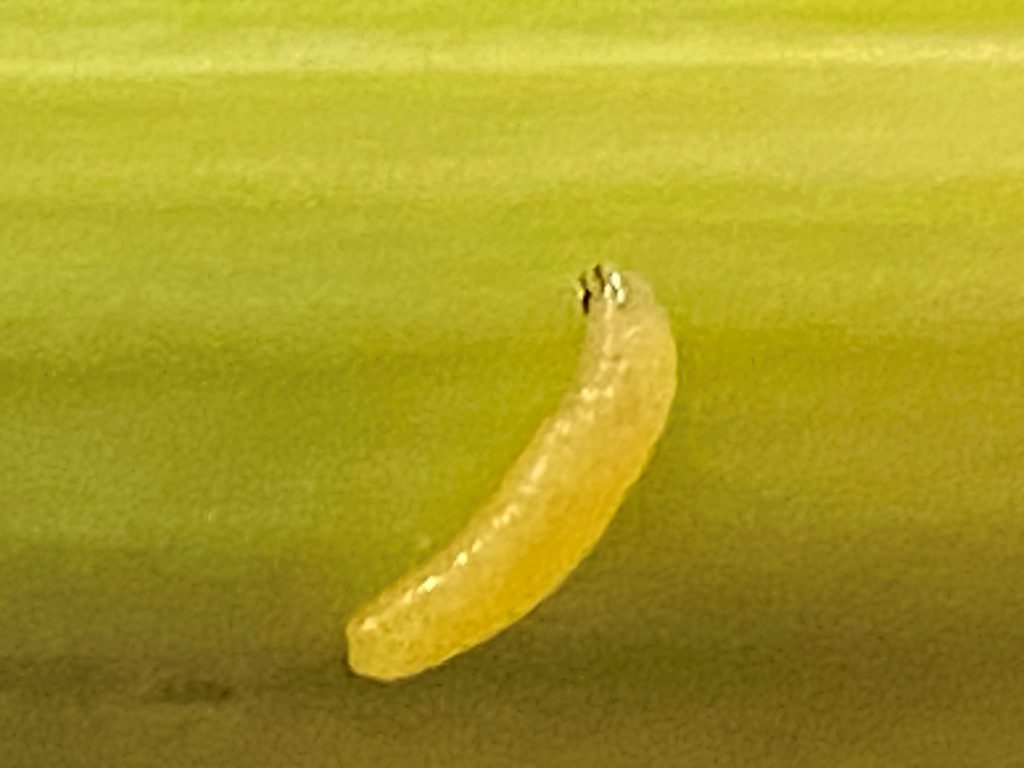



Control: Covering plants in April-May, or September-October, during the adult flights, can exclude the pest. A number of systemic and contact insecticides can provide effective control including neonicotinoids, diamides, spinosyns, and pyrethroids. Products registered for allium leafminer control include:
Mustang Maxx 2.88 to 4.0 fl oz/A zeta-cypermethrin
Warrior 1.28 to 1.92 fl oz/A lambda-cyhalothrin
Scorpion 35SL 8.75 to 10.5 fl oz/A dinotefuran – soil
Scorpion 35SL 5.25 to 7.0 fl oz/A dinotefuran – foliar
Venom 70SG 5.0 to 6.0 fl oz/A dinotefuran – soil
Venom 70SG 3.0 to 4.0 fl oz/A dinotefuran – foliar
Entrust SC (OMRI) 3.0 to 6.0 fl oz/A spinosad
Radiant SC 6.0 to 10.0 fl oz/A spinetoram
Trigard 75WSP 2.66 oz/A cyromazine
Exirel 13.5 to 20.5 fl oz/A cyantraniliprole
Minecto Pro 7.0 to 10.0 fl oz/A cyantraniliprole + abamectin
2022 Weed Management Field Day
Corn, Soybean, and Small Grains
June 14th, 2022
8:30 to 11:00am
Location: Southern Piedmont AREC. We will not be at the main station, but park directly in the field. Look for signs between Blackstone and the main station on Hwy 40/Darvills Road.
Google Maps link to field entrance: https://goo.gl/maps/iKZmYnjx7wM2
Field entrance near: 1200 Darvills Road, Blackstone, VA 23824. GPS is not always accurate. Field entrance between Nottoway Lanes and Military Road.
Continuing Education Credits Approved:
- NRCS Conservation Planner: 2.0
- DCR Conservation Planner: 2.0
- DCR Nutrient Mgmt Planner: 1.0
- Certified Crop Advisor: 2.0 (Pest Mgmt)
Please register by texting 540-315-2954 or emailing flessner@vt.edu
Highlights:
- View over 100 herbicide plots
- Learn about herbicide resistant Palmer amaranth and common ragweed control options
- Cover crops for weed control
- Harvest weed seed control:
- Chaff lining
- Redekop Seed Control Unit
- Pasture herbicide plots
If you are a person with a disability and desire any assistive devices, services or other accommodations to participate in this activity, please contact Michael Flessner at (540-315-2954) during business hours of 8:00 a.m. and 5:00 p.m. to discuss accommodations 5 days prior to the event. *TDD number is (800) 828-1120.
Virginia Cooperative Extension is a partnership of Virginia Tech, Virginia State University, the U.S. Department of Agriculture, and local governments. Its programs and employment are open to all, regardless of age, color, disability, gender, gender identity, gender expression, national origin, political affiliation, race, religion, sexual orientation, genetic information, military status, or any other basis protected by law.
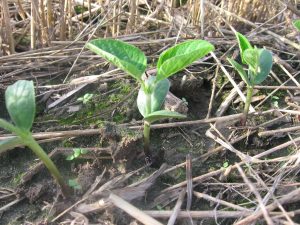
Cooler Soil Temperatures = Delayed Soybean Emergence
The upcoming weekend rainfall (our meteorologists seem assured that it’ll be widespread) should greatly help parts of Virginia that are short on or getting short of topsoil moisture and position us perfectly for a good start to the soybean growing season.
However, with the rainfall comes cooler soil temperatures. Below are predictions for 4-inch soil moisture and soil temperature over the next 10 days from Orange (one of the coolest parts of Virginia) and Suffolk (one of the warmest parts). As you see, soil temperatures will plummet from relatively warm (>60o) to nearly 50o or less over the weekend. While soybean seed will germinate and emerge in a reasonable amount of time at 60O, germination and emergence will be very slow when temperatures dip below this.
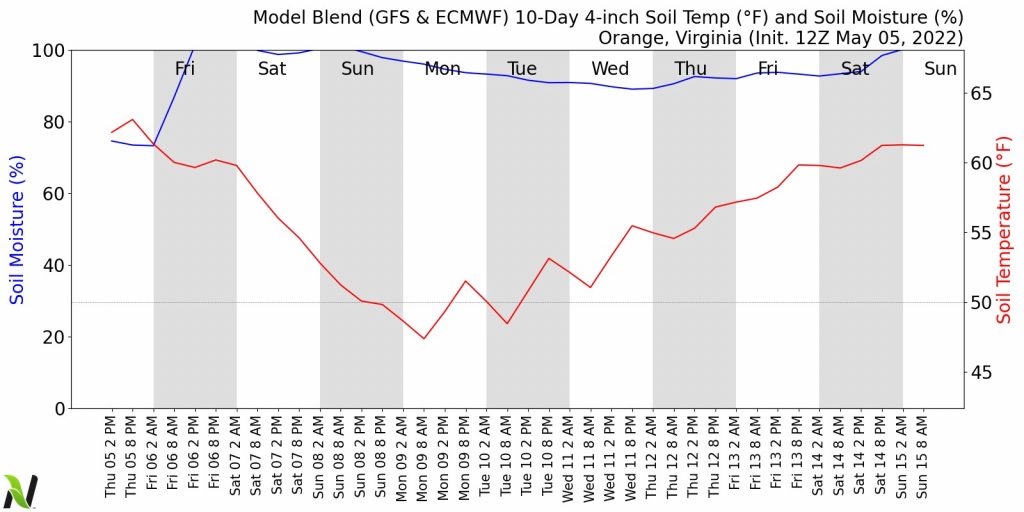
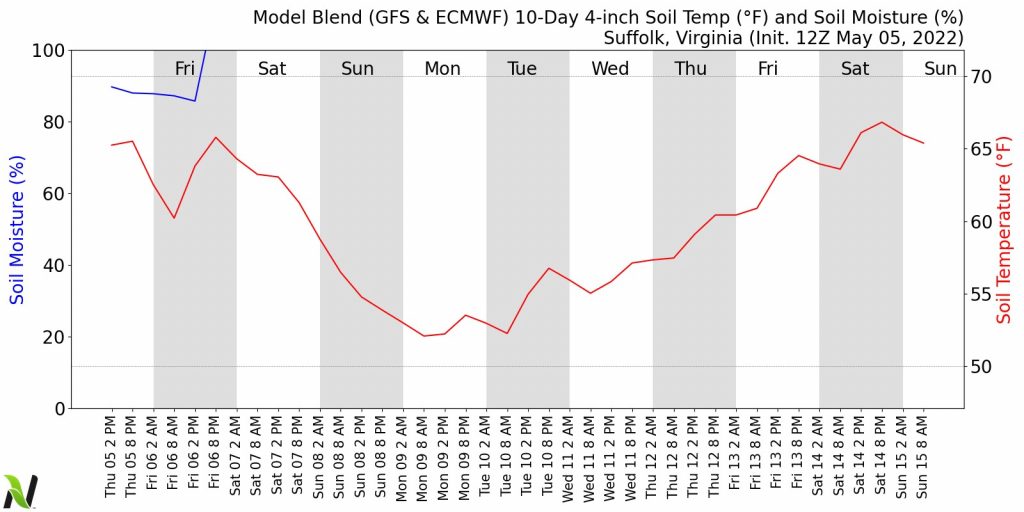
Therefore, heed my suggestion and make sure that you have a good fungicide seed treatment on anything that you are planting now or early next week.
Below is the fungicide efficacy chart from our Pest Management Guide. The main diseases that we need to concern ourselves with are Rhizoctonia and Fusarium sp. If in wet soils, Pythium and Phytophtora sp. could also be a problem with slow-emerging soybean. Be sure to protect a slow-emerging crop with a fungicide containing the active ingredients that provide good to excellent control of the appropriate disease.

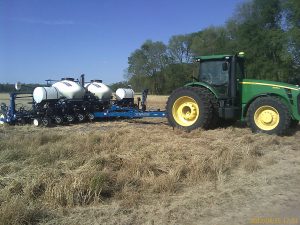
Soybean Planting Tips
Many may have already planted. Some have stopped planting other crops such and peanut and cotton due to cool soils and started planting soybean instead. Regardless, an advantage of soybean is that it tolerates a wide range of planting dates. I’ve found no advantage to planting soybean before May and have seen little yield penalty from planting as late as the first week of June, under most conditions. There are advantages to planting early and planting late, but that is not the subject of this post. Contact me for more detailed discussion on this matter-it will take more that a few comments.
With that said, I’ve always preferred May planting due to less risk of frost damage and slow emergence that is common with earlier planting. Still there are big differences in management when planting in early- versus late-May. Here I’ll review a few of these.
- Plant earliest maturing varieties first, then move to later maturing varieties. This will spread risk and harvest dates. We have however observed that early-planting and/or early-maturing varieties work better under productive soils/fields. If planting on poor soils/unproductive fields, later-maturing varieties will extend the growing season and push the critical pod- and seed-filling stages to less stressful times of the year.
- Always plant into moisture. But don’t plant more than 1 inch deep when soils are cool or emergence will be delayed substantially. One-half to 3/4 of an inch is adequate. For later planting dates when soils are warm, one can plant as deep as 1.5 inches and get rapid emergence.
- If planting into cool soils (usually before mid-May), use a good fungicide seed treatment. It could take 10 days or more for the soybean to emerge; plenty of time for soil-born seedling diseases to attack.
- A final plant population of 70 to 100 thousand plants per acre is usually adequate for full-season plantings. This means that 95 to 130 thousand seed per acre is enough, depending on expected emergence. Our research and in other states have observed that less seed is needed with low-yielding fields and greater seeding rates are needed with high-yielding fields. The problem is knowing how much the field will yield.
As always, contact me for more details regarding these tips or discuss other early-season soybean issues.
Wheat Disease Update 4/27/2022
I have had reports of powdery mildew showing up in a few fields lately. Look for white, powdery spots on leaves in the lower canopy. The undersides of leaves can be covered in the powdery growth of the fungus. Cool, humid, dry conditions favor infection, while prolonged periods of cool, humid weather in spring can allow the disease to reach the flag leaf and cause yield losses. If you see powdery mildew in your wheat prior to heading a triazole, such as propiconazole (Tilt and generics) can do the trick, but the earlier the application the better. Fungicides applied at heading for wheat scab are also very effective against powdery mildew.

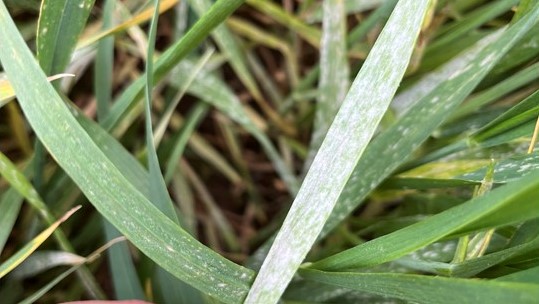
Wheat is heading and flowering across wheat growing regions in VA. The risk of wheat scab remains low due to dry, windy conditions. No fungicide application is warranted for scab management to crops that are currently flowering or will flower in the next several days. To assess risk of wheat scab, go to the web site https://www.wheatscab.psu.edu
Wheat Diseases – Diseases prior to heading and flowering.
It’s time to be scouting wheat for diseases and Virginia has had favorable conditions for disease development in wheat. There are really 2 times we should think about spraying wheat: 1) at Feekes Stage 9 (ligule visible on flag leaf); and 2) heading and early flowering (Feekes Stage 10.1 – 10.5). The spray at Feekes 9 is based on weather conditions and scouting while the Feekes 10.1 – 10.5 application is based on predicted disease risk and stage of flowering. Feekes 9 applications target powdery mildew, stripe rust, head and stem rust, Stagonospora leaf and glume botch, Septoria leaf blotch, and tan spot. The sprays at heading and flowering target wheat scab (Fusarium head blight). Most fungicides are efficacious against the diseases growers would spray for at Feekes 9 but only certain fungicides are recommended for sprays at heading and flowering as they have been shown to reduce the mycotoxin DON that the wheat scab pathogen produces. Also, strobilurins or FRAC Group 11 fungicides are not recommended for sprays at heading/flowering as these fungicides can actually increase DON levels. Fungicides recommended for DON are in the table below.

Fungicide efficacy for wheat diseases can be found in the Fungicide Efficacy Table produced by the Crop Protection Network at the following link: https://cropprotectionnetwork.s3.amazonaws.com/fungicide-efficacy-for-control-of-wheat-diseases-filename-2021-04-21-154024.pdf
Scouting for Wheat Diseases:
Begin scouting for wheat diseases around flag leaf emergence (Feekes 8) through Feekes 9 which is when the ligule of the flag leaf is visible. Be sure to look in different areas of the field, especially where wheat appears further along.
Pictures and descriptions of early wheat diseases are below.
Septoria tritici blotch: Look for elliptical or diamond-shaped, tan-brown lesions that often have yellowish halos. As lesions enlarge the center of the lesion dies and appears dark with small, dark specks which are fruiting bodies that give the lesion a characteristic speckled appearance. Subsequent lesions on higher leaves generally follow leaf veins, having straight edges and no yellow margin or halo. The dark lesion center and dark speckling is the key to distinguishing Septoria blotch from tan spot or Stagonospora leaf and glume blotch.
Symptoms of Septoria tritici blotch
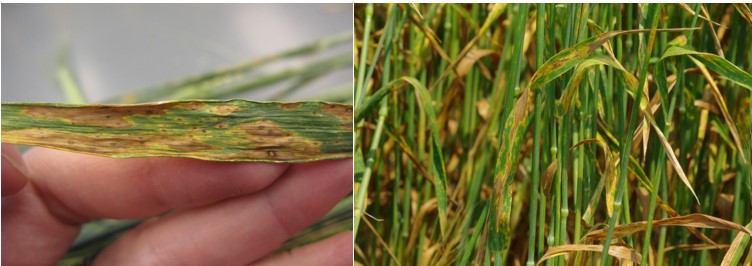
Left is a picture of Septoria blotch showing lesions with dark centers and little to no yellow halo except for new lesions. The right picture illustrates symptoms of larger lesions that have grown together.
Tan spot: Tan spot causes light brown or tan lesion with a light tan center that have a distinctive yellow halo (unlike Septoria that has a dark lesion center). Tan spot lesions are more oval than those of Septoria tritici blotch, but are more angular than Stagonospora leaf blotch lesions.
Symptoms of tan spot
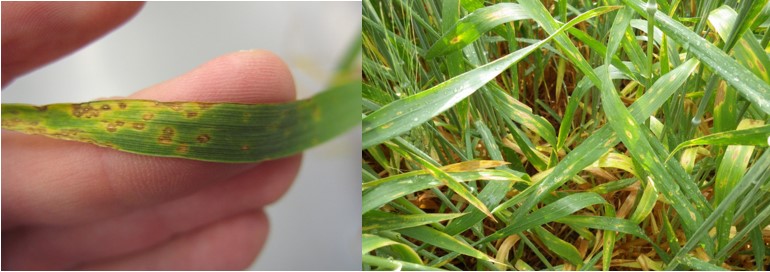
Left is a picture of tan spot lesions that are fairly oval and have tan centers. The right picture demonstrates the characteristic yellow halo caused by tan spot.
Stagonospora leaf and glume blotch: Foliar symptoms generally begin with small yellow flecks or spots. Spots grow to become lens-shaped lesions that are surrounded by yellow halos. Lesions are typically longer than those of tan spot but have a dark center like those of Septoria tritici blotch. However, a yellow halo is often present with Stagonospora and absent with Septoria. Symptoms on glumes appear as purple blotches or streaks.
Stagonospora leaf blotch symptoms
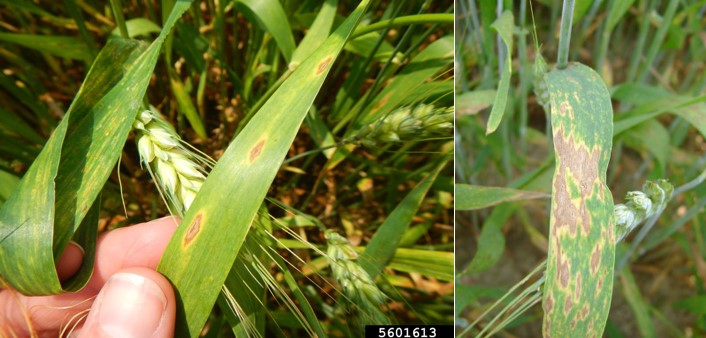
Left are early lesions while the right picture are coalesced lesions in more advanced infections. A distinct yellow halo is almost always present with Stagonospora.
Powdery mildew: Powdery mildew produces powdery, often fluffy fungal growth on stem and leaf surfaces. Leaf tissue can turn yellow under the powdery fungal growth. Signs of this disease typically appear on the lower leaves and work their way up the canopy. In advanced infections, little black dots can be seen in the fungal growth.
Signs of powdery mildew
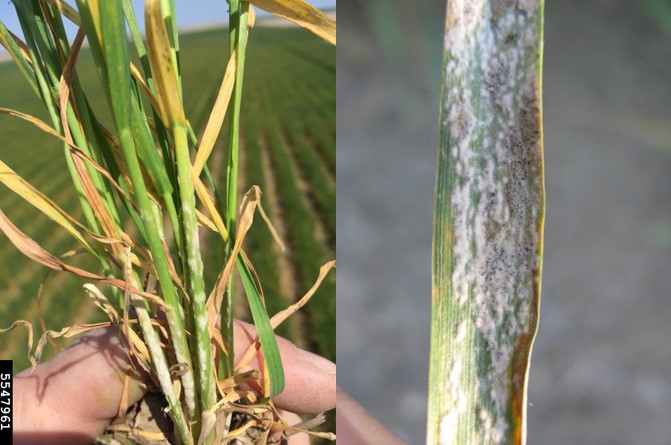
Left is fluffy fungal growth of powdery mildew on lower stems and leaves. On the right can be seen small, black fruiting bodies in the fungal growth.
Stripe rust: Although stripe rust doesn’t appear every year, when it does appear it can cause losses very rapidly. For that reason, you need to contact your local county agent or myself if you suspect stripe rust so we can quickly recommend control measures and alert other growers in the area of occurrence. Like most foliar diseases, strip rust starts out as yellowish flecks on leaves. From lesions appear yellow-orange, rust-like pustules on susceptible varieties. Pustules on mature leaves occur in parallel lines along the length of the leaf which appears as stripes.
Stripe rust symptoms and signs

Very linear sporulation and symptoms of stripe rust on left. Larger, coalesced lesions of stripe rust on right.
Most products in the aforementioned efficacy table are effective against these foliar diseases if applied just before or soon after symptoms appear.
Chlorpyrifos (Lorsban) no longer allowed on food crops
From Daniel Frank (Virginia Tech Pesticides Program):
As of February 28, 2022, all food tolerances for chlorpyrifos were revoked and any new applications of chlorpyrifos will render any food treated as adulterated and ineligible to be distributed in interstate commerce. In issuing the final rule, EPA found that it could not determine that there is a reasonable certainty of no harm from aggregate exposure, including food, drinking water, and residential exposure, to chlorpyrifos, based on currently available data and taking into consideration all currently registered uses for chlorpyrifos. EPA has a dedicated webpage including information for anyone in possession of chlorpyrifos products for use on food when tolerances expire. According to EPA,
• Applicators should discontinue use on food. If the products label allows for use in other non-food settings, it may continue to be used for those non-food purposes.
• Chlorpyrifos products should not be disposed of in landfills for industrial or municipal solid waste.
• Current options for dealing with chlorpyrifos products labeled for use on food:
o Store chlorpyrifos products until there is an opportunity for appropriate disposal. Details on proper storage can be found using the following links:
https://www.epa.gov/safepestcontrol/storing-pesticides-safely
https://www.epa.gov/pesticide-worker-safety/requirements-pesticide-storage
o Appropriately dispose of these products as specified by the state.
Information regarding the VDACS pesticide collection program including the 2022 service area and dates/times of collection were previously sent out and are also available here. Should any additional information become available related to the rule including other options for final disposition of the product, I will be sure to share that information.
Regards,
Daniel
—
Daniel L. Frank
Director of Pesticide Programs
Virginia Tech
302 Agnew Hall
460 West Campus Drive
Blacksburg, VA 24061
540-231-3430
vtpp.org
